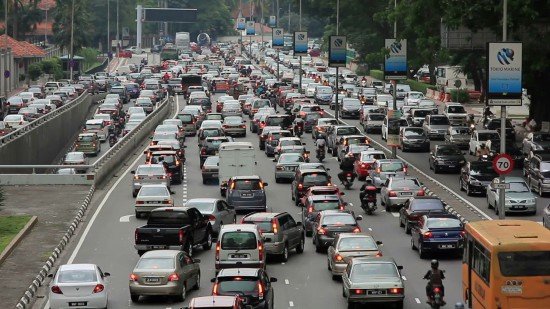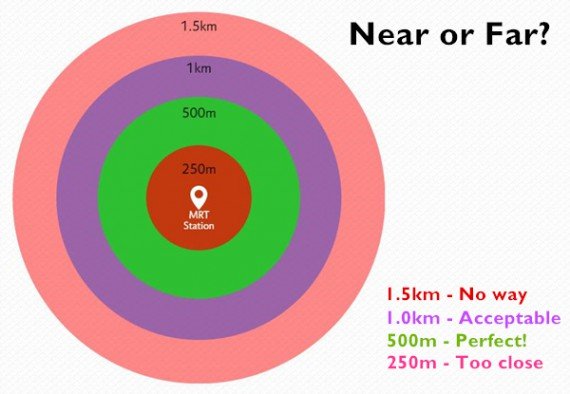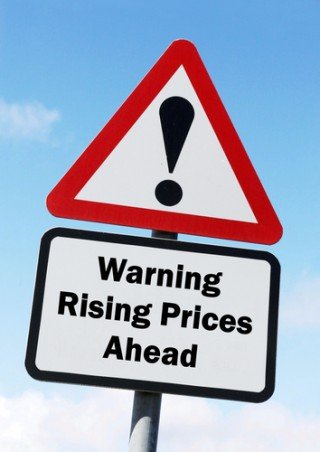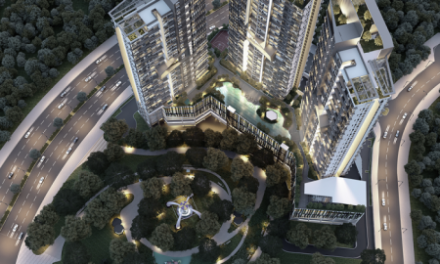Now that’s we’ve established (more or less) what is “The MRT Effect”, it’s time to expand on the five factors that contribute to it. These factors will explain why some properties near to train stations have better value or priced higher than others in the same vicinity. After all, not all properties are created (or in this case, built) equal.
1. Distance
More often than not, we see flyers saying proclaiming a new development is located ‘near’ or ‘walking distance’ to an LRT/MRT station, only to find that it is actually a 20-minute walk or 5-minute drive away. So what constitutes an acceptable walking distance to public transportation?
According to a survey carried out in London, it was found that properties within a 250m radius of a train station saw a 2-3% drop in prices as they were deemed ‘too close’, while those located about 500m away saw a significant increase of up to 10.5% in prices. Properties more than 1.5km away were not considered ‘near’ at all and thus were not affected by the presence of a station.
The ideal distance was about 500m, or less than 5 minutes walk, known as the ‘sweet spot’, while most agreed that a maximum distance of 1km or 15 minutes walk was acceptable. These areas are great if you are a long-term investor, as these properties will be able to hold their value longer. While it may come as a surprise at first that properties located very near to a station (250m or less) saw a drop in prices instead of the expected rise, it is also reasonable to say that homes in such close proximity to a public area would suffer from noise pollution and high traffic, thus negatively affecting its appeal. However, this would not affect hotels or offices, as the occupants are temporary and would prefer the ease of access that a station right below or next door will offer.
2. Demographic
Those in the low- and middle-income group stand to benefit the most from the completion of the LRT and MRT lines compared to those from the high-income group. Areas near to stations usually see a high population of students, working class adults, and foreign workers, whereas more affluent housing areas are less accessible by public transport. This is ostensibly to maintain the privacy of these areas, but also due to the fact that those in the higher-income group are able to afford their own vehicles and thus do not need to use public transport.
For example, the MRT Line 1 does not cut through middle-upper neighbourhoods like Bandar Utama, TTDI or Pusat Bandar Damansara; it only follows the main road and the two major stations in Bandar Utama and Kota Damansara serve to connect out-of-town areas to entertainment, shopping and offices. In other words, these are destination stations (i.e. KLCC) rather than outbound stations (i.e. in suburban housing areas).
In short? The MRT effect is not as strong in high-income areas, simply because the majority of residents already have their own means of transportation and do not require public transportation to get around.
3. Behaviour
It’s amazing how many things rely on human behaviour to determine its value or worth. In Malaysia, there is a heavy emphasis on car reliance, as it not only brings people door-to-door, but also acts as a status symbol of wealth and success (this in particular is very apparent in many Asian countries). One out of every 2.8 people own a car, and the use of public transport in Kuala Lumpur is a mere 20% compared to Manila (62%) and Hong Kong (80%). Most working adults spend about 2-4 hours driving to and from work daily because of lack of efficient public transport to the workplace, resulting in productivity loss of a whopping RM5.1 billion per year! That’s not all; more and more highway projects are feeding the demand for mobile culture. What kind of behaviour is this encouraging?

Who needs car parks when you’re stuck in an open-air car park every day going to and back from work?
Government policies and changing consumer behaviour to traffic are important factors that contribute to the MRT effect. Recent developments in the road and transport industry include a proposal for the implementation of a ‘congestion tax’ (similar to Singapore’s ERP system to manage road congestion within city limits), increased parking rates in the city, rising cost of building parking areas, and imported cars to increase prices next year. However, the recent hike in train fares has prompted an outcry from many commuters, and the transportation subsidy cut in Budget 2016 will mean further hikes in transportation services. By sending such mixed signals to the public, it is doubtful that people will be deterred from driving, neither will it reduce car ownership or make people embrace the MRT as a means to get from point A to point B.
Want to find out what are the two remaining factors? Stay tuned for Part 2 tomorrow! 😉








